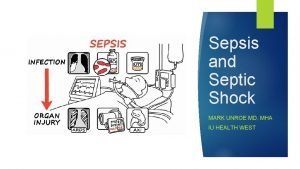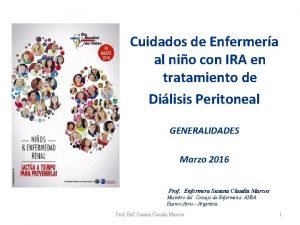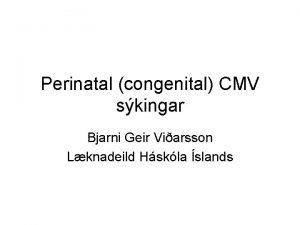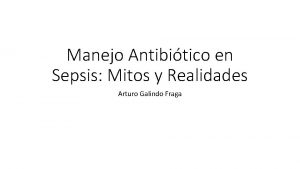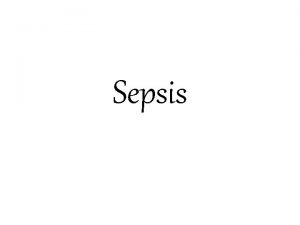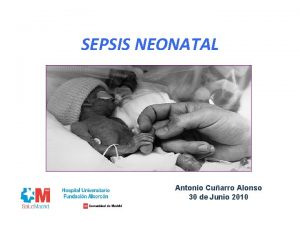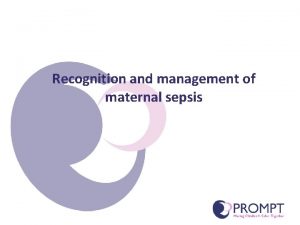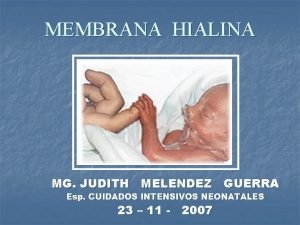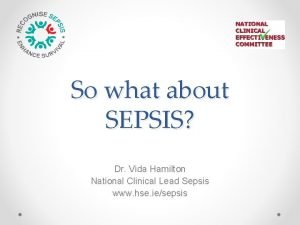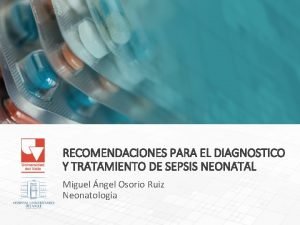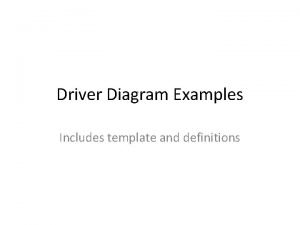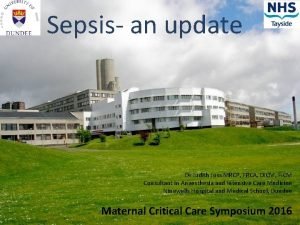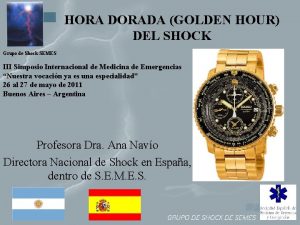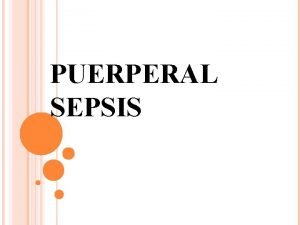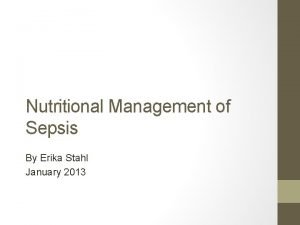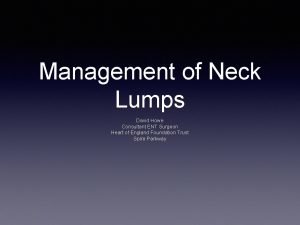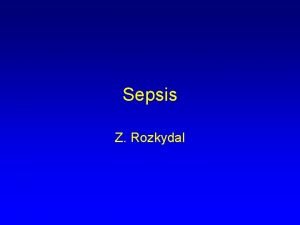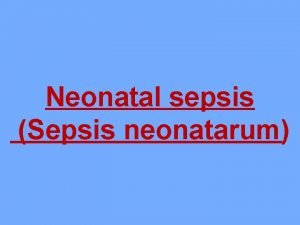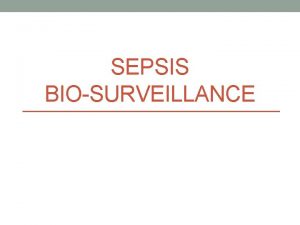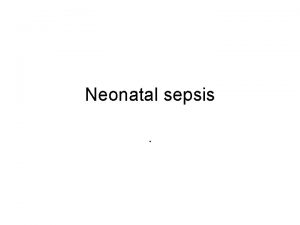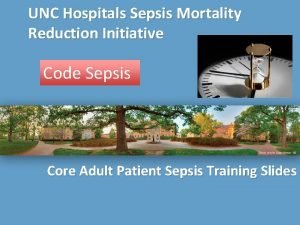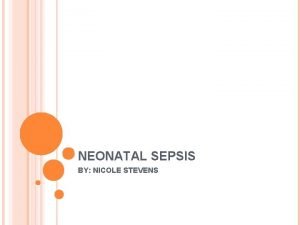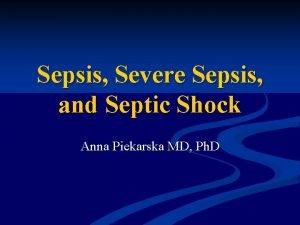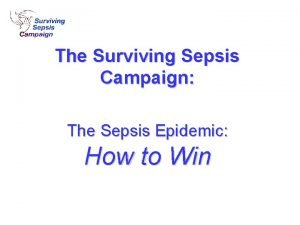Sepsis ED Induction Teaching What is Sepsis ACCPSCCM




















- Slides: 20

Sepsis ED Induction Teaching

What is Sepsis?

ACCP/SCCM Consensus Definitions • Infection - Inflammatory response to microorganisms, or invasion of normally sterile tissues. • Systemic Inflammatory Response Syndrome (SIRS) - Systemic response to a variety of processes. Bone RC et al. Chest. 1992; 101: 1644 -55

SIRS criteria • Temperature >38. 3 or <36 o. C • Heart rate >90 min-1 • Respiratory rate >20 min-1 • New Confusion • BM > 7. 7 (non diabetic) • White cells <4 or >12

ACCP/SCCM Consensus Definitions • Sepsis - 2 SIRS criteria AND proven/suspected infection • Severe Sepsis – Sepsis AND evidence of organ dysfunction/ hypoperfusion Bone RC et al. Chest. 1992; 101: 1644 -55

Criteria for organ dysfunction and hypoperfusion • New/increased O 2 requirement to maintain Sp. O 2 • • • >90% Cr >177µmol/l or <0. 5 ml/hr UO over 2 hours Bili > 34 µmol/l Plts < 100, INR >1. 5 or APTT >60 s SBP < 90 mm. Hg or MAP <65 mm. Hg SBP >40 mm. Hg lower than normal BP Lactate >2

ACCP/SCCM Consensus Definitions • Septic Shock – Sepsis AND hypotension despite adequate fluid resuscitation - SBP <90 mm. Hg or MAP <65 mm. Hg or lactate > 4 after “adequate” fluid resuscitation Bone RC et al. Chest. 1992; 101: 1644 -55

Why does Sepsis matter? • Incidence • - STEMI = 600, 000 per year - CVA = 115, 000 per year - Severe Sepsis/Septic shock = 40, 000 per year Mortality - STEMI = 4 -6% with treatment - CVA = 12% - Severe Sepsis =35% - Septic Shock = 50% http: //www. survivesepsis. org Dellinger RP et al. Surviving Sepsis Campaign: International guidelines for management of severe sepsis and septic shock: 2008. Crit Care Med. 2008


Surviving Sepsis Campaign • International effort to improve awareness and outcomes • Evidence-based guidelines to the management of severe sepsis & septic shock • Development of SEPSIS SIX http: //www. survivesepsis. org Dellinger RP et al. Surviving Sepsis Campaign: International guidelines for management of severe sepsis and septic shock: 2008. Crit Care Med. 2008

Severe Sepsis Screening Tool • Are any 2 of the following SIRS criteria present and new to your patient? • • • Temperature >38. 3 or <36 0 C Respiratory rate >20 min-1 Heart rate >90 bpm Acutely altered mental state White cells <4 x 109/l or >12 x 109/l Glucose>7. 7 mmol/l (if patient is not diabetic) If yes, patient has SIRS

• Is this likely to be due to an infection? • • For example Cough/ sputum/ chest pain Dysuria Abdo pain/ diarrhoea/ distension Headache with neck stiffness Line infection Cellulitis/wound infection/septic arthritis Endocarditis If yes, patient has SEPSIS Start SEPSIS SIX

SEPSIS SIX • High flow O 2 • Take blood cultures • IV Antibiotics (& source control) • IV fluid resuscitation • Measure Hb & lactate • Monitor urine output (consider catheter) • WITHIN 1 HOUR

Check for SEVERE SEPSIS/ SEPTIC SHOCK • BP • • Syst < 90 / Mean < 65 (after initial fluid challenge) Lactate > 4 mmol/l Urine output < 0. 5 ml/kg/hr for 2 hrs INR > 1. 5 a. PTT > 60 s Bilirubin > 34 μmol/l O 2 Needed to keep Sp. O 2 > 90% Platelets < 100 x 109/l Creatinine > 177 μmol/l or UO < 0. 5 ml/kg/hr Severe Sepsis/ Septic Shock Review immediately Senior Review +/- Critical Care Review

SSC • Adherence to SSC guidelines (including sepsis 6) leads to a reduction of 20% in mortality The Surviving Sepsis Campaign: results of an international guideline-based performance improvement program targeting severe sepsis. Levy MM et al. ; Intensive Care Med. 2010 Feb; 36(2): 222 -31

CEM Guidelines

Trust/Departmental Guidelines

Common Pitfalls (after Audit) • Identifying severe sepsis can be difficult – early • • lactate needed. Oxygen – high flow oxygen if severe sepsis/septic shock unless good reason not to. Senior Review – we can’t help if we don’t know Antibiotics – 7. 6% increased mortality with each hour delay Request urine output monitoring

Questions

Summary SEPSIS SIX • • • High flow O 2 Take blood cultures IV Antibiotics (& source control) IV fluid resuscitation Measure Hb & lactate Monitor urine output (consider catheter) • WITHIN 1 HOUR
 Quick sofa
Quick sofa Micro teaching definition
Micro teaching definition Sepsis bundle
Sepsis bundle Nanda hipertension
Nanda hipertension Bjarni geir viðarsson
Bjarni geir viðarsson Sepsis
Sepsis Quick sofa
Quick sofa Cuarro
Cuarro Sepsis 6
Sepsis 6 Sepsis pp respiratorio
Sepsis pp respiratorio Give 3 take 3 sepsis
Give 3 take 3 sepsis Sepsis neonatal temprana y tardía
Sepsis neonatal temprana y tardía Driver diagram example
Driver diagram example Sepsis criteria
Sepsis criteria La hora dorada medicina
La hora dorada medicina Puerperal sepsis definition
Puerperal sepsis definition Sepsis dietary management
Sepsis dietary management Sepsis infection pictures
Sepsis infection pictures Neonatal sepsis symptoms
Neonatal sepsis symptoms Hypotensis
Hypotensis Neonatal sepsis
Neonatal sepsis
